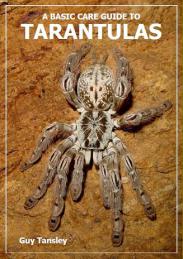
Many members of the genus Ceratogyrus Pocock, 1897 commonly
found in captivity are characterised by the presence of a foveal protuberance that ranges in size from a small mound to a large horn (there are
exceptions, C.
meridionalis for example) which is thought to aid the spider with
increased food storage, much needed in the dry scrubland where they naturally exist (note that the horn is less developed in mature males). All of the commonly kept species listed can be housed in
similar conditions and as they are prolific web spinners, they often clothe their entire container with thick silk so cage ornaments aren't necessary. The container can be allowed to dry out somewhat
between sprayings as they benefit from a slightly drier environment though an open water dish is essential in these circumstances. A cork bark or half flowerpot hide is also preferable, at least
until the spider settles in. Considered highly defensive (no tarantula should be labelled aggressive), they aren't considered the best species for beginners and often any disturbance will be met with
the usual leg-raised threat posture and highly audible stridulation. Most are easily paired if the female is receptive (Ceratogyrus spp. males posses
tibial spurs) and egg sacs typically contain 100 - 150 eggs. Egg sacs are suspended in a hammock-style web and the female guards these jealously throughout the incubation period of around 3 - 5 weeks
depending on temperature etc. C.
marshalli has the most pronounced foveal
horn, C. brachycephalus possesses a forward pointing horn and the abdomen is symmetrically spotted and striped, a typical feature in the Harpactirinae. All can be
identified to genus level by the presence of a light ventral band on the abdomen.
Common species in captivity:
C. brachycephalus - Hewitt, 1919
Botswana, Zimbabwe, South Africa
Similar to other members of the genus but somewhat lighter in colour. Can be distinguished by the forward pointing horn. Not as common
as C. bechuanicus and C.
darlingi but captive breeding is becoming more
common.
C. darlingi - Pocock, 1897
Zimbabwe, Mozambique
A burrowing species typical of the genus. Symmetrically spotted and striped abdomen and variegated patterns to the legs of various shades of brown, grey and black. A rear pointing horn that can vary
in size between individuals. Easily bred in captivity so spiderlings should be readily available.
C. marshalli - Pocock, 1897
Zimbabwe, Mozambique
The species with the most impressive foveal horn that varies in size between individuals. Similarly patterned to other members but darker in overall colour. Commonly bred in captivity so spiderlings
should be available.
C. meridionalis - (Hirst, 1907)
Malawi, Mozambique
A medium sized dark brown species that lacks the typical foveal horn. The carapace instead is covered with lighter hairs arranged in a radial pattern. Still relatively rare in the hobby but recent
attempts at breeding this once common species have been successful so captive bred stock should be more readily available in the coming
years.
C. pillansi - (Purcell, 1902)
Zimbabwe, Mozambique
Another species that lacks a foveal horn and is rare in collections.
C. sanderi - Strand, 1906
Namibia, Zimbabwe
Very similar to C. brachycephalus but the forward pointing horn is somewhat reduced in comparison.

